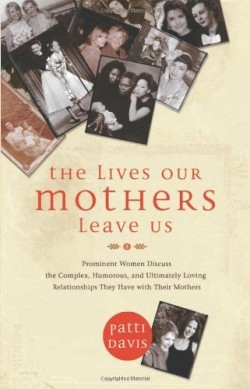It looks like you've stumbled upon a page meant to be read by our code instead of viewed directly. You're probably looking for this page.
The Lives Our Mothers Leave Us
Prominent Women Discuss the Complex Humorous and Ultimately Loving Relationships They Have with Their Mothers
“Even if our mothers are gone, they are never gone from us. If we search our internal landscapes, we find them—sometimes etched as delicately as a watermark, sometimes as deep as an engraving. Our mothers stand behind us in the mirror, trail our footsteps, tap on our shoulders. If you burrow under the surface of any woman, you’ll find what her mother thought about her.” With these words, author Patti Davis, daughter of Nancy Reagan and former president Ronald Reagan, brings readers into her exploration of the complex, sometimes humorous, and many times disturbing relationships between daughters and their mothers. But the greater theme of Davis’s book is love, and how the passing of time can of-ten provide the perspective necessary to make this love visible.
Davis has written seven books, both fiction and nonfiction, including The Long Goodbye and Two Cats and the Woman they Own, and has been published in many magazines including Time, Newsweek, Ladies’ Home Journal, Glamour, More, and Sunset. In this latest work, she brings a mature compassion to her exploration of the mother—daughter relationship, and shares the stories of a wide spectrum of prominent women including Marianne Williamson, Whoopi Goldberg, Candice Bergen, Diahann Carroll, Lorna Luft, Mariel Hemingway, Lily Tomlin, Anna Quindlen, Anne Rice, and others whose revelations about their relationships with their mothers are at first surprising, and then reassuring as it becomes apparent that all daughters must en-counter, and grow beyond, the difficulties inherent in that most passionate of relationships.
Davis begins with her own story by spending some time alone in the house her parents shared after their White House years. She recalls her father’s lingering decline into the oblivion of Alzheimer’s disease, and the devoted and loving care her mother gave him. She has vivid memories of the love between them, the kind of love that, “when they looked at each other, the rest of the world fell away.” She then speaks of her own conflicted relationship with her mother. Instead of “the sort of talks friends might have in late-afternoon sunlight over cups of tea,” she said, “I tried her patience, and she intimidated me.” It was only with the passage of time, and after the death of her father, that Davis was able to say, “At some point, I stopped looking back at the journey and just enjoyed where we’d ended up. Apparently, so did she.”
Part of a daughter’s journey to understanding involves being able to look beyond what she wishes her mother would be to learning to see her as she is—and to recognize and accept that her mother is also learning and growing. Those mothers who learn how to nurture themselves and their children give them an irreplaceable gift—the gift of a childhood blessed with the assurance that they are loved and respected.
Although some of the women presented here reminisced about happiness shared with mothers who were available, nurturing, and proud of their daughters, many had painfully difficult relationships with mothers who were, for reasons of their own, unable to show their daughters love. Yet, even in these cases, the passing of time led to an understanding of the sufferings endured, enabling the daughters to replace bitterness and pain with compassion and the realization that their mothers had done the best they could.
Davis suggests that it is “hard work to step back and look at both your childhood and your parents’ lives in the context of time and social realities. It often feels like a cross between therapy and archeology.” Looking closely at one’s parents—the way they live their lives and the choices they have made—often makes one want to run in the opposite direction. Davis and the other gifted women who have shared their stories in this remarkable and insightful exploration into a variety of mother—daughter relationships remind readers that, “We form inside our mother’s womb, far from her arms but right beneath her heart. It’s that beating heart—so close to our own—that some of us eventually run from, believing we can leave it behind. Believing we have to leave it behind in order to discover who we are. But the emptiness swallows us, and we return to the heart that never stopped waiting for us.”
Disclosure: This article is not an endorsement, but a review. The publisher of this book provided free copies of the book to have their book reviewed by a professional reviewer. No fee was paid by the publisher for this review. Foreword Reviews only recommends books that we love. Foreword Magazine, Inc. is disclosing this in accordance with the Federal Trade Commission’s 16 CFR, Part 255.
